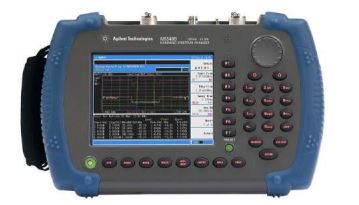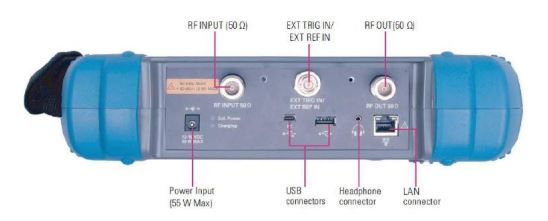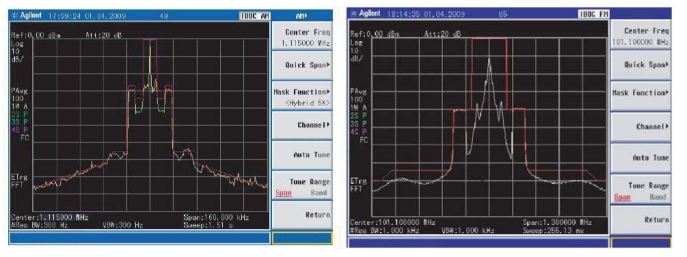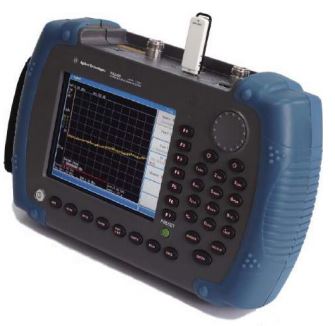The Agilent N9340B Portable Spectrum Analyzer

[August 2009] For many years making spectrum measurements at a radio station meant hauling a large, heavy test instrument into the field. Now, there is a better way. Phil Alexander looks at a state-of-the-art spectrum analyzer and shows us a really light way of getting the data every FCC inspector demands when reviewing your files.
Last August in Austin, Texas, Alan Alsobrook and I were doing the 2008 Radio Guide AM Transmission Seminar in conjunction with the Texas Association Broadcasters convention. Barry, our intrepid organizer and leader is always bringing new and interesting stuff to the seminars. This time his latest find was a prototype of a new hand-held spectrum analyzer from Agilent, the N9340B.

The Agilent N9340B
I thought I had seen this movie before, but for contrast – and perhaps for ballast – I had packed my trusty old Hewlett-Packard 8568B for comparison. For those who are not familiar with it the HP 8568 is a big, lab-quality instrument that does everything but move easily from place to place. At around 100 pounds, it is more “luggable” than portable, but it does break down into two 50 to 60-pound cases – plus a small plotter for recording traces.
Generally speaking, I only put up with it because it will do almost anything I ask of it; and once it is set up it is easy to use. Since the 8568 is the direct ancestor of the newer Agilent E440x models the major transmitter manufacturers treat as the “gold standard” of spectrum analysis, I thought it would make a great “then and now” comparison for our seminar class – and I secretly expected to explain the differences as a list of things you give up when moving to new, lightweight instruments. Those of you who have complained to Quincy about IBOC boxes that appeared to have the digital output set a bit too high and have heard the standard, “Well, have you checked it on an E4402?” refrain know this drill very well.
In other words, my expectations were low although I thought a comparison would be an interesting educational experience for those attending the seminar. I fully expected to hear that if you needed to do some difficult measurements – such as measuring an AM-IBOC hybrid station’s output to NRSC-5 standards – the instrument of choice should be the Agilent E4402 – just as the guys from Quincy had trained us.
Breaking the Standard Mold
However, all my preconceptions were shattered when I met Randy Tanner from Agilent and we talked about his amazing little blue and gray box. It was just a casual conversation at first, but when I asked how the N9340B compared with the E4402 etc., what I heard surprised me.
Randy said, “That was a problem for us and is a reason we had to delay the launch longer than we would have liked.” He went on to say that their design standard for noise was essentially the same performance as the E4402 specification. The first attempt did not succeed so they started over and accomplished their goal. The more we talked the more interested I became in this little box.
Design Philosophy
The basic design of the N9340B is a strong and capable hardware platform which maintains the familiar operating characteristics of its heritage. If you know how to operate any HP/Agilent spectrum analyzer built within the past 30 years most of the basic N9340B operation will seem intuitive.
On this basic platform, Agilent has engineered a wide range of options into the software. This includes options for NRSC OBW measurements in AM-IBOC hybrid mode, an on-board tracking generator, power and field intensity measurements, and many other options.
What is an OBW you ask? You will not find anything in the FCC Rules unless you know that they mean “Occupied Band Width.” FM and TV stations must run an OBW measurement if they make changes that might affect their emissions. AM stations are required to do it once a year.
With this system upgrades to keep the instrument up to date with the latest advances become simple and easy. In fact, the N9340B is a work in progress, but one that is already well advanced and continuously improving.
What is an OBW you ask? You will not find anything in the FCC Rules unless you know that they mean “Occupied Band Width.” FM and TV stations must run an OBW measurement if they make changes that might affect their emissions. AM stations are required to do it once a year.
A Reversal of Opinion
The N9340B fits into a hand-held enclosure about 12-½ inches wide with a 6½-inch LCD screen. It is slightly over 8 inches high and less than 2¾ inches thick. Complete with battery and a heavy ballistic nylon carrying case that has covers that open for normal operation, it weighs – are you ready? – all of about eight pounds – less than a tenth of my trusty old HP!
For the frequent fliers there is also a well-cushioned hard case, complete with an extendable towing handle and roller wheels. Unfortunately, both cases share one fault. Neither the basic soft case nor the hard case has room for the cables, adapters and accessory items needed for use with the analyzer, so be prepared to carry a small gadget bag full of these things.
Responsive Fixes
As with any prototype, I found a few aggravating functions in the demonstrator I evaluated for this article. For example, it had a nasty habit of calculating upper and lower span limits as a percentage of center frequency, thus moving from 1000 kHz to 1500 kHz increased the span by fifty percent. While this might be useful in some product development labs it added much tedious and unnecessary fiddling whenever the setup was changed from one station to another.
That same instrument was one of two that Randy Tanner displayed at the NAB show in Las Vegas in April. When I commented about this and one or two lesser complaints Randy said he had loaded the latest updates before bringing the instruments to the show. It seems others had objected to the original algorithm, and therefore it was fixed, along with other improvements.
This time, rather than the span recalculating itself, it stayed exactly where I put it for the first measurement through several center frequency changes. For an old hardware guy, software does seem to have a few advantages – among them, being able to buy only as much instrument function as you need, perhaps starting out with a minimum of functions and adding more when needed or as the budget permits.
In the Field
Working with the N9340B is about as easy as it gets. One essential accessory is the 12-Volt adapter that allows keeping the battery full while working all day in the field. On the other hand, if you only need a couple of measurements, a fully-charged battery will probably outlast your laptop computer.

Topside on the N9340B
While there are several functions that make a laptop useful for taking a more detailed look at spectra than can be seen on the built-in LCD screen such as when spur hunting or making comparisons of multiple scans, the basic instrument works well as a stand-alone for all the standard measurements.
In my tests, I used one of Chris Scott’s LP-3 H-field antennas which is a good, widely used, shielded loop, but not known for high sensitivity. Using it directly, without the optional pre-amp function, I got excellent results with a couple of 5 kW stations before the fields of Central Indiana turned to mud in one of the wettest spring seasons on record.

AM and FM IBOC measurements with NRSC masks
Since the N9340B DANL (Displayed Average Noise Level) decreases 20 dB with the pre-amp function, I expect that even low power stations will not present all the challenges usually confronted while trying to obtain accurate spectra.
Brining Home the Data
Photos, data plots, arcane data files, a printout, a floppy disc – all have been used for data transport from field to office, but the N9340B uses none of the above. Instead, there is a USB slot to allow connection of a standard memory stick or thumb drive. Loading spectra in JPEG form is simply a few clicks on the menu screens, or the data can be left in the instrument and downloaded as the onboard memory fills up.

The USB connection allows data to be easily downloaded to a flash drive
I like the memory stick idea, especially since I do not want to risk making a mistake and writing over or erasing my data. Back in the office, importing the JPEGs directly into a report is very simple and takes far less time than cleaning up some of the older data for report presentation.
A Reversal of Opinion
Not only will the Agilent N9340B do everything – and more – than my old reliable HP 8568B, it is nearly 100 pounds lighter. I put my order in immediately, and am awaiting delivery of my own unit in mid-August.
A 16-page brochure detailing the Aglient N9430B feature set can be found here.
– – –
Phil Alexander CSRE, AMD, is a veteran broadcast engineer based in Indianapolis, IN. Contact Phil at dynothem@earthlink.net
